The Saxmundham to
Aldeburgh branch line
and Garrett Works spur
These
photographs by Richard Casserley date from the 14.5.1956 (the
Saxmundham
postcard is probably
earlier). Notes to the photographs by the photographer in italics. You can
see that they took a day trip down the line; more photographs from this
set can be seen on the Felixstowe
Branch Line page.
Saxmundham Station
The only station still in use on this page (Leiston still
stands, but the only rail traffic hauls nuclear waste flasks from
the gantry, just the other side of Sizewell gates),
Saxmundham
is on the main line from Ipswich to Lowestoft. The former Aldeburgh
line branches off to the north-east of the station and is still used
for nuclear freight only, although there are hopes to reopen Leiston
for passenger traffic.
(1) - Saxmundham 14/5/56, Class J15,
65447 with 7-24 to Aldeburgh.
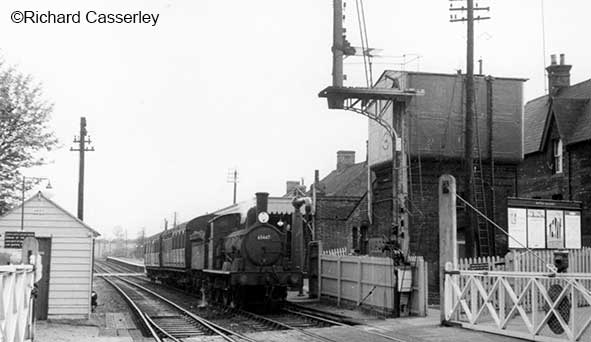
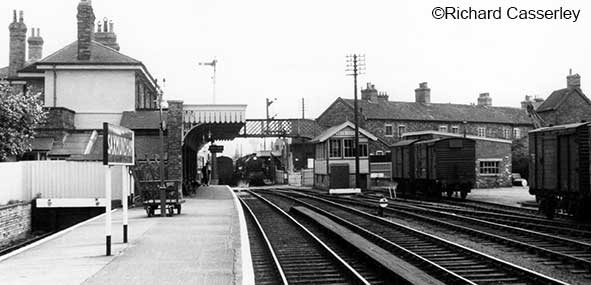
The main feature of Saxmundham station used to be the staggered
platforms either side of one of the first of the two level crossings
(Station
Approach and Chantry Road respectively). Today the Lowestoft platform
stands opposite the Ipswich platform, extending up from the signal box,
which is still there; passenger access to the new platform is via a
railed walkway behind the signal box. The engine shed has long gone.
(3) - Saxmundham 14/5/56,
65447 with 7-24 to Aldeburgh.
(4) - Saxmundham 14/5/56, Class B12, 61564
with 1-30 Liverpool St. - Gt.Yarmouth.
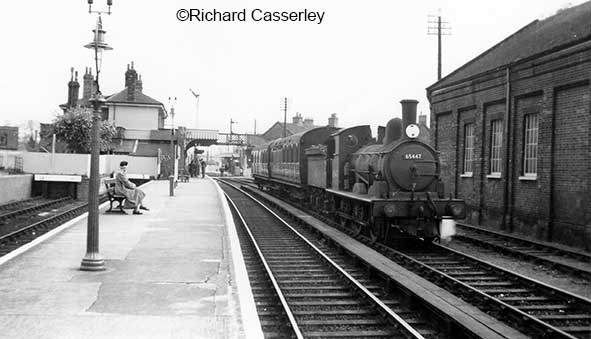
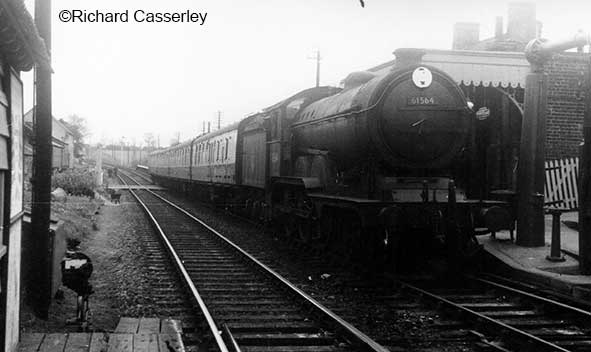
Below: a postcard image of Sax in its heighday; lots of staff,
lots of structures including a covered footbridge and the still extant
signal box and impressive locomotive. Seems to be going
the wrong way...

The Leiston Works spur
Sirapite is a very rare shunting engine. It is part traction
engine and part locomotive and was built in 1906 by Aveling and Porter
for Gypsum Mines Ltd at Mountfield in Sussex. Its name comes from a
product similar to plaster of paris which was produced by the company;
'Sirapite' was decided to be more suitable than 'Parisite'. Sirapite
was bought by Richard Garrett & Sons and brought to Leiston in
1929. It was used to replace the horses which had been used to control
the trucks which conveyed goods and materials on tracks between the
workers' houses to and from the town site (where today's Long Shop
Museum is located) to the top works and Leiston railway station.
Sirapite was the visible link between the company and the townspeople,
trundling backwards and forwards across the main road, supervised by a
man with a red flag (see below).
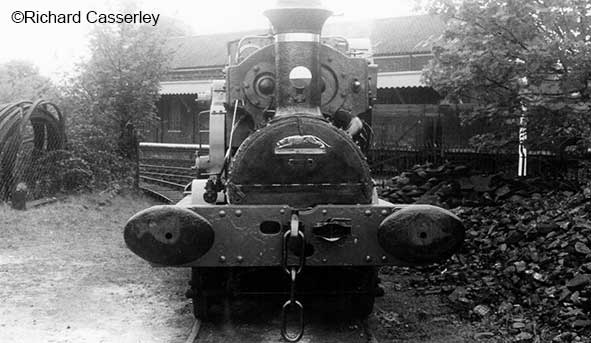
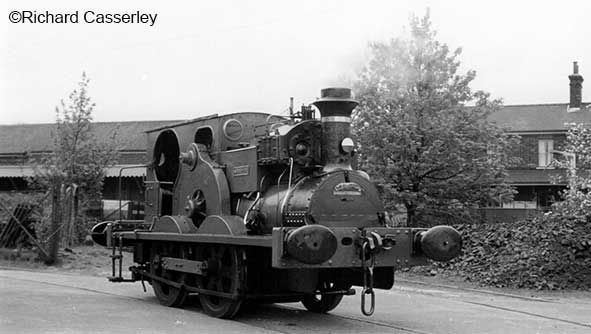
This remarkable sequence of photographs follows Sirapite, with
the Garrett's panther emblem on the front, on the
spur from Leiston Station (visible in the background above) on its way
past the 'top works' and down to the town works of Garrett's
engineering.


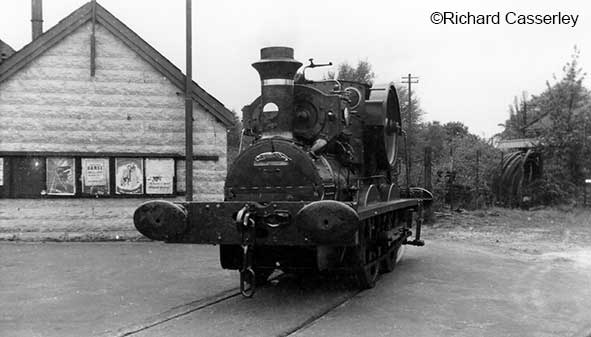
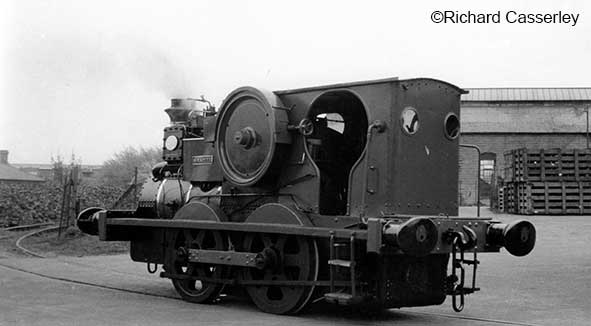
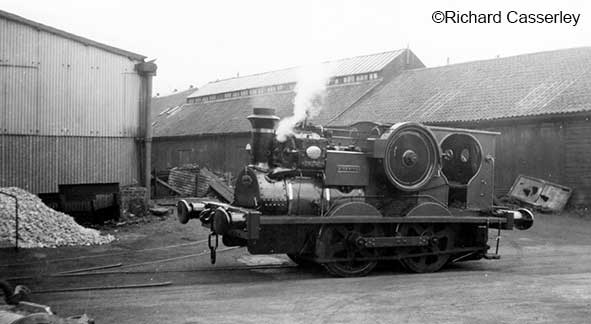
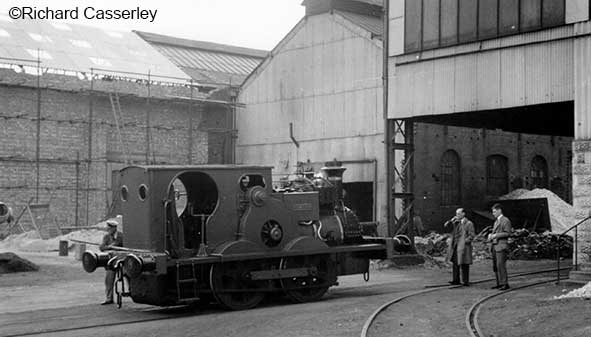
Below: we see, from the footplate of Sirapite, the crossing
point on Leiston's Main Street, with a worthy with red flag to hold up
the traffic during the passage of the locomotive into the town works.
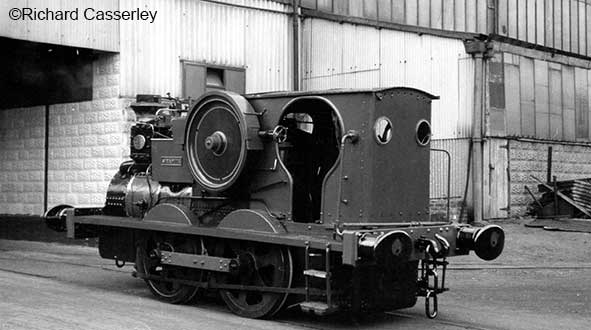

Below: Sirapite, having crossed Main Street, climbs the incline
into the town works.

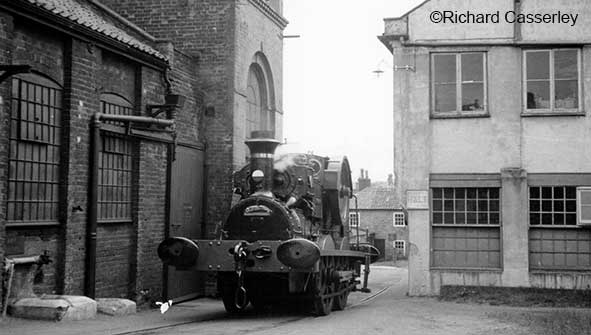
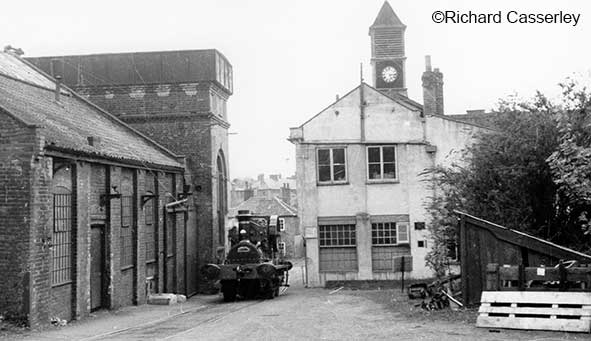
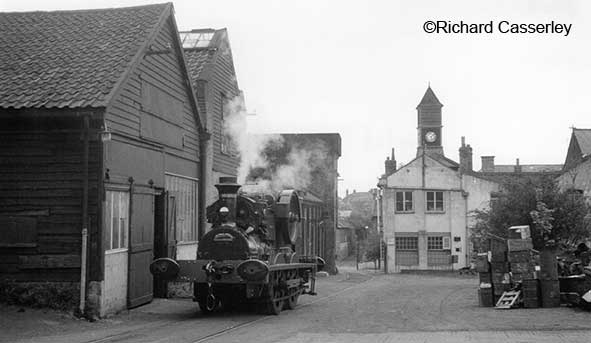
The line in Leiston was introduced in 1929 to replace the
Suffolk Punch horses which had transported materials and goods for
Richard Garrett & Sons. The shunting engine, Sirapite, which ran
the line until 1962 has already been restored. The following project is
to restore the inclined track between the beer garden of The Engineers
Arms and Leiston Station. John Keeble, trustee of Leiston Works Railway
Trust: "Hopefully in a year to two years we will have the line down and
Sirapite going up it." Sirapite was replaced by a
Battery Electric Locomotive in 1962 and moved on from Leiston. It was
bought in 2004 by the trustees , where it currently has 100 feet of
track to move along. The electric engine was used until the line was
dismatled in 1968.
There is a fine gallery of images to supplement the Casserley
photographs here on the Leiston Works Railway website (see Links), which shows locomotives on the narrow
incline beside the public library and the beer garden of the Engineer's
Arms.
Thorpeness Halt
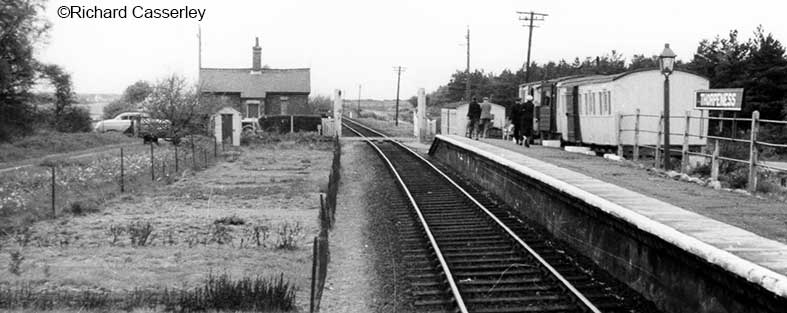
These remarkable photographs of Thorpeness Station, known
locally as Thorpe Halt, show that it was more than just a raised
platform in the middle of nowhere. It has gas lighting, a timber-built
shelter, bench and three old coaches, one of which seems to be
converted into a box office. There are also a sack
barrow and a luggage trolley, which suggests that a porter might be on
hand. The crossing cottage at the end of the platform is still there on
the Aldringham to Thorpe road. Today this sandy cross-over is used by
golfers pulling their wheeled golf-bags from one hole to the next.
Indeed one segment of the
passengers arriving here would have come to stay at the Country Club or
hotel by the club-house and to practice their golf; no doubt a
horse-drawn carriage or automobile would collect them. Other,
perhaps less wealthy, travellers might have the long walk into the
village or back down the road to Aldringham.

The above shot shows that Thorpe Halt even had its own siding.
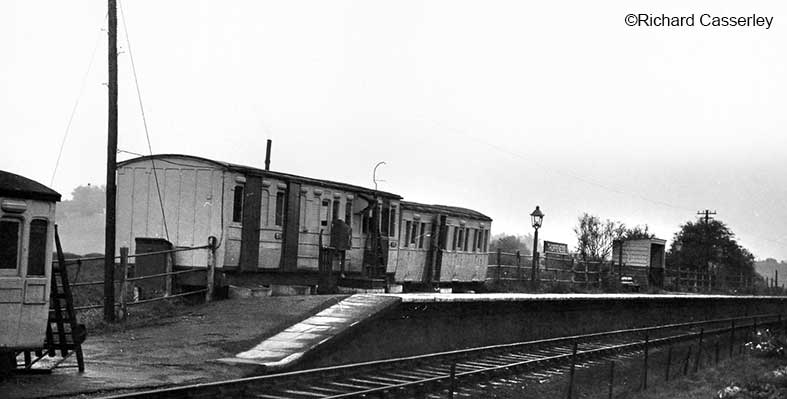
Although tucked away, the platform does still exist on this
site: a
lonely reminder of the chugging engines, steam and bustle on the
single-track line to and from Aldeburgh.
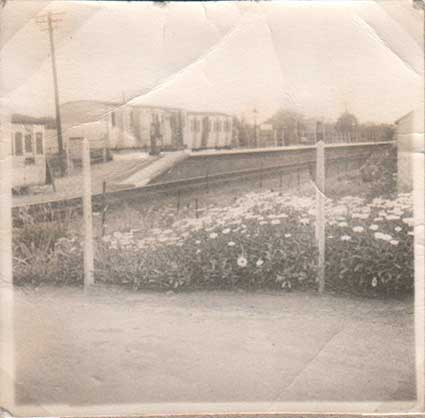
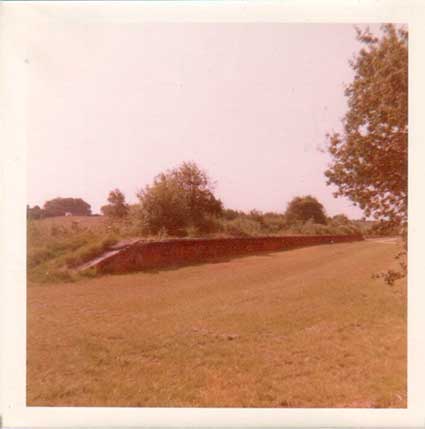 Summer
1971 image
Summer
1971 image
Above: undated snapshot of Thorpe Halt and a
summer 1971 photograph from more-or-less the same position. We believe
that the platform is still in place, although it was overgrown the last
time we visited.
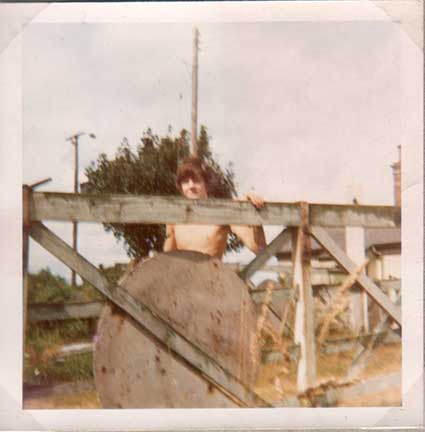 Summer
1971 image
Summer
1971 image
Above: dodgy character at
the Sheepwash crossing gates between Leiston and Thorpeness, 1971.
The red paint on the central circle is faded but recognisable.
The crossing cottage is visible in the right background.
This is not a road, but a farm-track crossing.
Aldeburgh terminus
(23 to 25) - Aldeburgh
14/5/56, 65447 with 6-45 to Saxmundham.
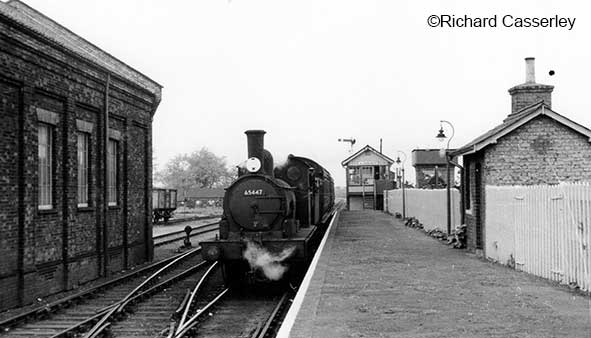
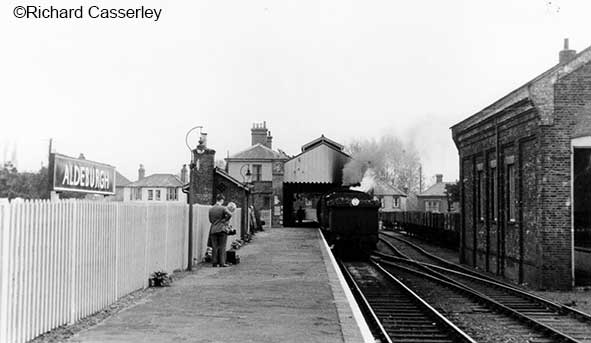
Some may recall the brick-built station standing rather forlonly
above a weed-strewn trackbed in the early seventies. These photographs
show that there was a large canopy projecting from the station building
over both platform and track. The overall roof at
Aldeburgh was demolished in 1965.
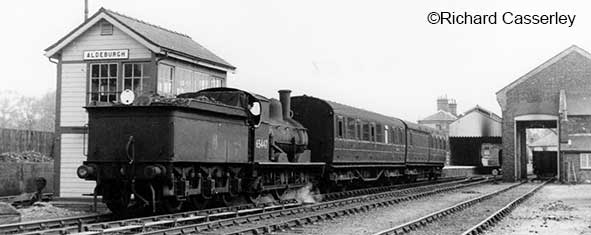
In Aldeburgh, by 2015 everything connected with the railway has
gone,
apart from the
public house: the Railway Inn on Leiston Road.
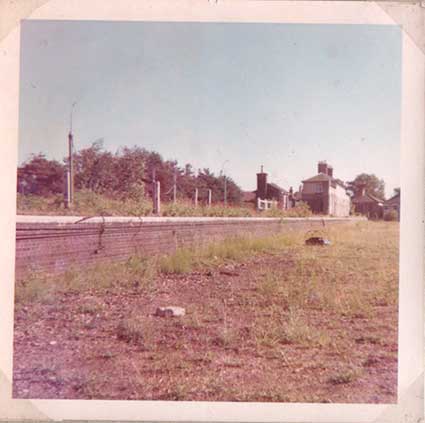

Stranded in time, these were the Aldeburgh Station remnants in
summer 1971. The main station building with its mainly blind arches on
the platform side displays the substantial brick columns at each end,
which supported the large over-canopy.
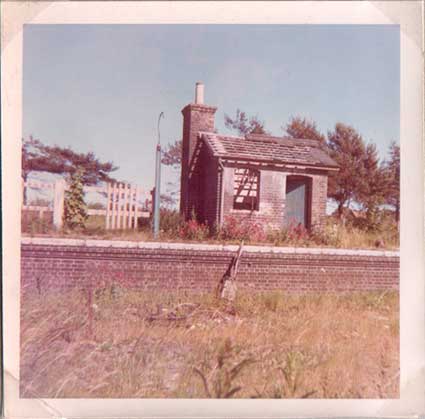 Summer
1971 images
Summer
1971 images
Further down the platform, broken palings, an old gas lamp
standard and derelict platform building.
In 1963 the Beeching Report recommended closure of the Aldeburgh
branch but there was significant local opposition. Finally on 12
September 1966 passenger services were withdrawn. Garrett's Leiston
spur was closed in 1968. In 1972 the Saxmundham Junction signal box was
demolished and by 1975 Aldeburgh station building was demolished and a
housing estate was built on the site.
See also Richard Casserley's period
photographs (and some by his father) of the Ipswich-Westerfield-Felixstowe
branch line .
Eastern Counties signals & regulations
book 1846
; this link takes you to a weg-page for a download of all the
pages in the 1846 railway booklet.
Home
Return to Historic Lettering from outside
Ipswich
Please email any comments and contributions by clicking here.
Search Ipswich
Historic Lettering
©2004 Copyright
throughout the Ipswich
Historic Lettering website: Borin Van Loon
No reproduction of text or images without express
written permission























 Summer
1971 image
Summer
1971 image Summer
1971 image
Summer
1971 image




 Summer
1971 images
Summer
1971 images